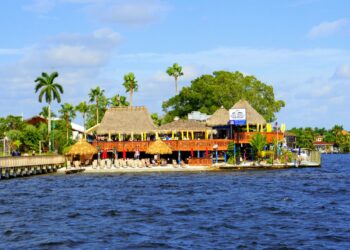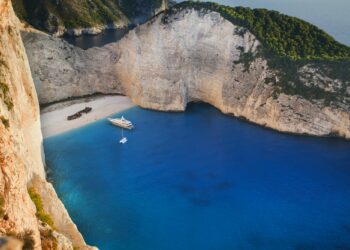As travellers, we’re drawn to certain things; the vast, beautiful expanses of rugged mountain ranges, serene, secluded beaches, the ruins left by ancient civilisations and the world-changing architecture in modern cities. The list goes on and on, and everyone’s list will be a little different. I think, though, something on every traveller’s list of places to visit will be castles. There is something inherently appealing about them. Maybe it’s the fact that many are in idyllic settings, high on hilltops overlooking forests or river valleys. Because there is so much history, we can learn about the people who called these places home and the battles fought to protect their surrounding lands. Whatever the reason, something steers a traveller’s compass towards castles. But our fascination with them is where their similarities end.

The UK has much to see as a visitor. On my way to Scotland, I faced a dilemma. Edinburgh Castle or Stirling Castle? They are the two most popular castle visits in Scotland and are located near each other. Some say Edinburgh is best to visit, others Stirling. Since I’d be staying in both cities, I decided to compare the two myself and tell you all what I found. If you find yourself travelling in Scotland, you can choose where to spend your vacation dollars.
Affiliate Disclaimer: Our blog posts may contain affiliate links. If you make a purchase through these links, we receive a modest commission at no extra cost to you. These commissions help us fund our team of travel writers, allowing us to continue providing you with the latest travel news, tips, and inspiration. Your support keeps this blog alive and thriving, and we appreciate it immensely. Thank you!
I visited Stirling first, and from the cemetery that sits next to the castle, there is a decent view of the hilltop it sits on. From this vantage point, there are two big buildings and part of a castle wall visible. ‘That’s it?’, I thought. There didn’t seem to be much going on, but when walking towards the entrance gate, you’ll realise several buildings make up this castle. They ranged from small to very big and were built by many generations of royalty that ruled there. I rented the audio guide while touring the castle grounds and went to every room in every open building. After spending about 17 pounds for my day at the castle (about $25 USD), I wanted to get my money’s worth! Also, I wanted to have the whole experience so I could compare Stirling to Edinburgh. The audio guide was very informational and engaging. It told the story of each building on the castle grounds, the people who built them, as well as a lot of Scottish history.
Like Stirling, Edinburgh Castle is not a typical Disney-esque-looking castle with one enormous main building complete with towers and battlements that dominates a landscape and is surrounded by wall and moat. It, too, has several buildings that were built over centuries. Also, like in Stirling, to get the whole castle experience, I rented the audio guide and went into every open area. Again, the audio guide was filled with great historical information about the castle and interesting facts about the kings and queens who ruled there.
Tour
Edinburgh
Like at Stirling, Edinburgh Castle has Regimental Museums, a Great Hall, an old chapel, and a Royal Palace. It also has some interesting extras like the Scottish Crown Jewels, the Scottish National War Memorial, and Prisons of War. There is also the One O’clock Gun, which supposedly fires nearly every day at precisely 13:00 since its inception in 1861 as a time signal for ships in the Firth of Forth. Although I say supposedly because of the eight days I was in Edinburgh, I did not hear the One O’clock Gun once.

Stirling
It is interesting to walk through all the buildings, including the Royal Palace (which recreates how it would have looked in the mid 16th century), the Great Hall that is the largest ever in Scotland, and the Chapel Royal (built-in 1594 for the baptism of James VI’s first son). The complex also houses The Argyll and Sutherland Highlanders Regimental Museum, , which tracks the history of the Argyll and Sutherlands British Army regiment, formed in 1881 and based at Stirling Castle, the Stirling Heads Gallery, which showcases much of the carvings from around the complex, and the Castle Exhibition that shows a timeline and information of all monarchs that shaped the castle. To me, it felt more like a museum.
Beauty and view from each one
Edinburgh
Again, many buildings make up the castle grounds. Unlike Stirling Castle, there’s not as great a visual contrast in building styles. I’m sure someone more versed in architectural styles from these periods would see dozens of differences from building to building. Still, to a layman, they seem similar. It is still a beautiful setting for sure; there just aren’t the striking variances you see at Stirling.
The castle sits on a high point in the centre of Edinburgh, thus has a great view in all directions. This includes a view of Arthur’s Seat to the east and the Firth of Forth to the north.

Stirling
Many buildings in the complex are all built at different periods and in a mix of building styles. The visual differences of the buildings make going through the ‘village’ an interesting and beautiful walk. My favourites are the Great Hall, the Chapel Royal interior and the old gatehouse.
The castle sits on a hill on the edge of Stirling. There is a good view of the city and the River Forth. Looking east, you can see The National Wallace Monument and the Ochil Hills a few miles away.

Price
- Stirling 14 pounds + 3 for the audio guide
- Edinburgh 16 + 3
Advantage, push (I think they’re both overpriced, just like seemingly everything in the UK)
Planning Your Visit to Edinburgh Castle
Opening Hours
The castle is open seven days a week, with seasonal variations in opening times. The castle typically opens at 9:30 AM. Closing times vary between 4:00 PM and 6:00 PM, depending on the season. Please check the official website for the most current information.
Tickets
Tickets can be purchased online or at the castle entrance. Purchasing online is recommended, as this can help you skip the line at the ticket office. Prices vary for adults, children, and seniors, with family tickets also available.
Accessibility
The castle is built on a steep and rocky hill, so accessibility can be challenging for people with mobility issues. However, efforts have been made to improve accessibility, including providing a mobility vehicle service from the esplanade to the top of the castle.
Highlights of Edinburgh Castle
Crown Jewels and the Stone of Destiny
Scotland’s Crown Jewels are among the oldest regalia in Europe, dating back to the 15th and 16th centuries. They are housed in the Crown Room, along with the Stone of Destiny, an ancient symbol of Scotland’s monarchy, used for centuries in the inauguration of its kings.
The Great Hall
The Great Hall is an impressive, grand room that was built for James IV in the early 16th century. It’s known for its ornate wooden ceiling and houses a collection of weaponry and armour.
St Margaret’s Chapel
St Margaret’s Chapel is the oldest surviving building in Edinburgh. It was built in the early 12th century and is a fine example of Romanesque architecture.
The Royal Palace
The Royal Palace comprises a suite of rooms that were the royal apartments of Scotland’s monarchs. It’s also the birthplace of James VI of Scotland (and I of England).
The Prisons of War
The vaults beneath the Great Hall were used as a prison during various wars in the 18th and 19th centuries. Today, it serves as an exhibit that provides insight into the conditions prisoners faced.
Mons Meg
Mons Meg is a gigantic, medieval siege cannon, presented to James II in 1457. It’s one of the most popular exhibits in the castle.
Tips for Your Visit
- Plan Enough Time: There’s a lot to see at Edinburgh Castle. Plan to spend at least 2-3 hours exploring.
- Comfortable Shoes: Due to the rocky and uneven terrain, comfortable walking shoes are recommended.
- Arrive Early: The castle can get quite crowded, especially during the peak tourist season. Arriving early can help you avoid the largest crowds.
- Guided Tours: Free guided tours are available and are a great way to learn about the castle’s history. Check the schedule upon arrival.
- Camera: Don’t forget your camera! The views of Edinburgh from the castle are spectacular.
Edinburgh Castle is a window into Scotland’s rich and complex history. Whether you’re a history enthusiast, a lover of architecture, or simply looking to experience one of Scotland’s premier tourist attractions, the castle offers a unique and fascinating journey through time.
Accommodation near Edinburgh Castle
Booking.comPlanning Your Visit to Stirling Castle
Opening Hours
Stirling Castle is open seven days a week throughout the year, except for Christmas Eve, Christmas Day, Boxing Day, and New Year’s Day. The castle is open from 9:30 AM to 5:00 PM in the summer and until 4:00 PM in the winter. Please check the official website for the most recent information.
Tickets
Tickets can be purchased online or at the castle. Buying tickets online is generally recommended as it helps to avoid lines at the entrance. Discounts are available for children, seniors, and families.
Accessibility
The castle is relatively accessible, with ramps and lifts for wheelchair users. However, due to the historic nature of the site, some areas may still be challenging for people with mobility issues.
The Palace
The Palace is one of the best-preserved Renaissance buildings in the UK. It was the home of Scotland’s monarchs, with impressive rooms that have been restored to their 16th-century glory.
The Great Hall
The Great Hall, or the Parliament Hall, is the largest of its kind ever built in Scotland. It was used for feasts, dances, and the Scottish Parliament meetings.
Chapel Royal
Chapel Royal, with its beautiful frescoes, was the place where many significant events of Scottish royalty took place, including the baptism of James VI’s eldest son, Henry.
The Kitchens
The Kitchens give a fantastic insight into the grand feasts prepared for the royal court. The sights, sounds, and even smells of these bustling areas have been re-created.
Queen Anne Gardens
These gardens offer beautiful views over the surrounding landscape and are a peaceful spot to wander.
Regimental Museum
The Argyll and Sutherland Highlanders Regimental Museum is located within the castle and chronicles the history of the regiment from the 19th century to the present.
Tips for Your Visit
- Plan Ahead: There’s a lot to see at Stirling Castle. Expect to spend at least 2-3 hours exploring.
- Comfortable Footwear: The castle grounds are quite extensive, and the terrain is uneven in places. Make sure to wear comfortable shoes.
- Guided Tours: Free guided tours are available, offering a wealth of information about the castle’s history.
- Camera: Don’t forget your camera. The castle offers splendid views of the surrounding landscape.
- Arrive Early: To avoid crowds, especially during peak season, it’s best to arrive early in the day.
Stirling Castle is more than just an iconic landmark; it’s a fascinating journey through Scotland’s tumultuous history. Its magnificent architecture, beautifully restored interiors, and captivating stories make it an unmissable attraction for anyone visiting Scotland. Enjoy your visit!
So, two votes (tour & view) to one (beauty) for Edinburgh over Stirling on my personal comparison. Both were very interesting, and there’s a lot of information to soak in. History buffs would have a great day just reading the news and listening to the audio guide at either site. I think they are definitely worth visiting, but if you’re in the area, pick one. Going to both is slightly redundant.
I’ve visited many castles while travelling in Europe, and one thing I’ve learned: all castles are not equal. Some are dark, others very colourful. Some are near present-day city centres, others much more secluded. Some look the part of a picturesque Disney fairy tale castle, some aren’t so beautiful, and others are just plain ugly. Some overlook small rural communities, while other urban sprawls. Many show the scars of countless battles; some never saw one. And some, after centuries of life, lie in ruins, while others stay well-preserved.











